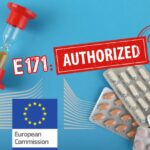
The world of the infinitely small

The domain of the infinitely small
By the AVICENN team – Last modification February 2023
What infinitesimal are we talking about?
Nanotechnologies: making and manipulating nano-objects
Nanotechnology refers to the processes of manufacturing and/or manipulating structures at the nanometric scale (nm), that of the infinitely small. They are at the molecular and atomic scales. As an indication :
- some viruses are a hundred nm in diameter
- human DNA is 2 nm wide,
- and a carbon or hydrogen atom measures 0.1 nm
The term “nanotechnology” was coined in 1974 and began to develop in the 1980s with the creation of the scanning tunneling microscope and the atomic force microscope.
What is a nano-object?
Nano-objects or nanoparticles are like nano-grains but can have very different forms (wires, platelets, particles or nanoporous substances) and are generally grouped together, especially in powder form.
From a chemical point of view, to simplify, they are different from “classical” substances in two ways:
- first, their size: these particles are of very small dimension because they are at the nanometric scale
- then, nanoparticles and nanomaterials have different properties from those of conventional materials: they can change color or become more conductive, more solid, more photocatalytic for example.
Manufactured nanomaterials
Manufactured nanomaterials are man-made materials at the nanoscale that have “extraordinary” properties (in the true sense of the word) compared to materials structured at the micro- or macroscopic scale.
They are different:
- … from natural nanoparticles found in erosion or volcanic eruption dust, or in sea spray for example. Many viruses are also nano-sized.
- ... as well as from so-called “incidental” nanoparticles which are produced “involuntarily” and are present :
- in Mayan paintings, Roman glassware (Lycurgus’ cup) or in Damascus swords from the 10th century, in wood burning fumes, etc., all well before the industrial period
- and more widely in industrial fumes or those emanating from diesel engines and other so-called “ultra-fine” particles1See for example the participatory project NanoEnvi The project is funded by the CNRS and is being carried out by the Geosciences Environnement Toulouse (GET – CNRS/University of Toulouse III – Paul Sabatier/IRD/CNES) laboratory of the Observatoire Midi-Pyrénées (OMP), and involves researchers in environmental magnetism, sociology and physics from the Laboratoire d’aérologie (LA – CNRS/University of Toulouse III – Paul Sabatier) and the Laboratoire physique et chimie des nano-objets (LA – CNRS/University of Toulouse III – Paul Sabatier).Mélina Macouin, CNRS researcher at the Geosciences Environment Toulouse Laboratory (GET-OMP, CNES/CNRS/IRD/UT3 – Paul Sabatier), from toasters or ovens, for example, or wear and tear of tires and brake pads
2See for example:
In French :
– Action Needed to Reduce Particulate Matter Emissions from Automotive Parts and Pavement Wear, OECD, December 2020
– Air pollution: new knowledge on ambient air particles and the impact of road traffic, Anses, 16 July 2019
– Nano-safety: Brake pad emissions under the microscope, CEA Liten, 11 June 2019
– Particle emissions from brakes: a future health scandal?“, Sciences & Avenir, 21 September 2018
In English:
– Brake dust exposure exacerbates inflammation and transiently compromises phagocytosis in macrophages, Selley M et al, Metallomics, 2020
– Pollution warning over car tyre and brake dust, BBC, July 11, 2019, etc..
Despite their differences, engineered nanomaterials and ultrafine particles (UFPs) share many commonalities, particularly in terms of challenges concerning tools to detect, measure and characterize them or to evaluate their risks3Cf. Nanomaterials Versus Ambient Ultrafine Particles: An Opportunity to Exchange Toxicology Knowledge, Stone V et al, Environmental Health Perspectives, 125(10), 2017.
While there are already several hundred different substances marketed at the nano scale (more than 300 are registered in the French r-nano register and also listed on the European nanomaterials observatory), the vast majority of nanomaterials used by industry belong to the following four categories:
They are most commonly found in the form of ultra-fine powders (in creams, lotions, sprays, dressings…), to which humans or the environment can be directly exposed.
They can be incorporated into solid materials (such as carbon nanotubes in bicycle frames), in which case they do not come into direct contact with humans or the environment during their use, but potentially during their production or during the degradation of the products at the end of their life cycle.
Specific properties
Indeed, the interest and the increasing development of nanomaterials can be explained by the specific properties that can be created by modifying matter at the nanometric scale, in particular the size or other physicochemical characteristics of materials.
At the nano scale, the material deploys new or more marked properties, notably because of their small size, which gives them a larger reaction surface than the same non-nanometric material. Why? Because the proportion of atoms on the surface (compared to the volume) is greater than for larger materials, allowing for greater exchanges and interactions with their environment4See for example:
– Nanoparticles: Is Toxicity a Concern? D R, Rao P. EJIFCC, December 2011
– Reactivity of inorganic nanoparticles in biological environments: insights into nanotoxicity mechanisms. Casals E, Gonzalez E, Puntes VF , Journal of Physics D: Applied Physics, 2012.
Two images to understand this “size effect“:
- visualize the surface covered by the contents of a spoonful of cocoa powder spilled on the table: it is equivalent to the surface of a whole chocolate bar
- cocoa powder melts faster in milk than large squares of chocolate
Also, nanomaterials are more “reactive” than non-nano materials.
At the industrial level, these new properties of nanomaterials are perceived as opportunities in many fields of application, hence the growing number of releated patents each year5See for example:
– Nanotechnology Published Patent Applications in USPTO: Number and Annual Growth Rate during the Past 20 Years, StatNano, December 30, 2020
– Nanomaterials with the Highest Number of Granted Patents in USPTO, StatNano, November 25, 2020
– Nanotechnology patents in USPTO (Patent), StatNano (accessed November 2020).
A sunscreen containing nanoparticles of titanium dioxide (TiO2) is more transparent than a “classic” cream whose TiO2 is not nano, thus avoiding white deposits on the skin, which brands use as a selling point.
New properties, new markets
Most nanoproducts on the market today offer advantages due to the addition of nanoparticulate powders that give them new properties, with various benefits:
- elimination of bacteria (and bad smells) for nanosilver, used in textiles, bandages, disinfectant sprays, coatings for refrigerators, keyboards, food packaging…
- strength and lightness for carbon nanotubes, which are a major asset, especially for the transportation industry
- sunscreen or photo-catalytic effect (anti-pollution) for titanium dioxide nanoparticles which, depending on their effect, can be used in sun creams or cements
- anti-caking and therefore fluidizing effect for nanosilicas used in foodstuffs, powdered sugar, table salts, etc.
- catalytic effect (triggering of chemical reactions) for metallic nanoparticles, with applications in the health field
- anti-fogging” effect obtained by laminating gold and titanium dioxide nanoparticles
- …
Properties ++ > Risks ++ ?
New properties” also mean, potentially, “new risks”. Hence the need for an effective vigilance on these.
However, the resources dedicated to the monitoring and prevention of these risks are still not what they should be. That is why AVICENN is keeping watch!
Any questions or comments? This information sheet compiled by AVICENN is intended to be completed and updated. Please feel free to contribute.
Our information sheets to go further
Upcoming Nano Agenda

- Scientific conference
- 23rd International conference on Advanced Nanomaterials
- From July 23 to July 25, 2025
- Website: www.advanced-nanomaterials-conference.com

- E-learning program: awareness-raising for personnel who come into contact with nanomaterials during research, formulation, production, maintenance, cleaning, upkeep, etc., as well as safety coordinators or engineers, facility managers, heads of laboratories where nanoparticles are handled.
- Organizers: INSTN Grenoble (CEA)
- On the program:
- 1 – Introduction, definition and characteristics of nanomaterials
- 2 – Toxicity of nanomaterials: the state of knowledge
- 3 – Metrology and characterization of nanomaterials
- 4 – Prevention and protection against nanomaterials in the workplace
- 5 – Quiz: assessment of learning outcomes
- The 2-hour course can be viewed for one month from the date of registration.
- Website: https://instn.cea.fr/…risques-lies-aux-nanomateriaux…

- E-learning program: awareness-raising for personnel who come into contact with nanomaterials during research, formulation, production, maintenance, cleaning, upkeep, etc., as well as safety coordinators or engineers, facility managers, heads of laboratories where nanoparticles are handled.
- Organizers: INSTN Grenoble (CEA)
- On the program:
- 1 – Introduction, definition and characteristics of nanomaterials
- 2 – Toxicity of nanomaterials: the state of knowledge
- 3 – Metrology and characterization of nanomaterials
- 4 – Prevention and protection against nanomaterials in the workplace
- 5 – Quiz: assessment of learning outcomes
- The 2-hour course can be viewed for one month from the date of registration.
- Website: https://instn.cea.fr/…risques-lies-aux-nanomateriaux…
File initially created in April 2011
Notes and references
- 1See for example the participatory project NanoEnvi The project is funded by the CNRS and is being carried out by the Geosciences Environnement Toulouse (GET – CNRS/University of Toulouse III – Paul Sabatier/IRD/CNES) laboratory of the Observatoire Midi-Pyrénées (OMP), and involves researchers in environmental magnetism, sociology and physics from the Laboratoire d’aérologie (LA – CNRS/University of Toulouse III – Paul Sabatier) and the Laboratoire physique et chimie des nano-objets (LA – CNRS/University of Toulouse III – Paul Sabatier).Mélina Macouin, CNRS researcher at the Geosciences Environment Toulouse Laboratory (GET-OMP, CNES/CNRS/IRD/UT3 – Paul Sabatier)
- 2See for example:
In French :
– Action Needed to Reduce Particulate Matter Emissions from Automotive Parts and Pavement Wear, OECD, December 2020
– Air pollution: new knowledge on ambient air particles and the impact of road traffic, Anses, 16 July 2019
– Nano-safety: Brake pad emissions under the microscope, CEA Liten, 11 June 2019
– Particle emissions from brakes: a future health scandal?“, Sciences & Avenir, 21 September 2018
In English:
– Brake dust exposure exacerbates inflammation and transiently compromises phagocytosis in macrophages, Selley M et al, Metallomics, 2020
– Pollution warning over car tyre and brake dust, BBC, July 11, 2019, etc. - 3Cf. Nanomaterials Versus Ambient Ultrafine Particles: An Opportunity to Exchange Toxicology Knowledge, Stone V et al, Environmental Health Perspectives, 125(10), 2017
- 4See for example:
– Nanoparticles: Is Toxicity a Concern? D R, Rao P. EJIFCC, December 2011
– Reactivity of inorganic nanoparticles in biological environments: insights into nanotoxicity mechanisms. Casals E, Gonzalez E, Puntes VF , Journal of Physics D: Applied Physics, 2012 - 5See for example:
– Nanotechnology Published Patent Applications in USPTO: Number and Annual Growth Rate during the Past 20 Years, StatNano, December 30, 2020
– Nanomaterials with the Highest Number of Granted Patents in USPTO, StatNano, November 25, 2020
– Nanotechnology patents in USPTO (Patent), StatNano (accessed November 2020)






